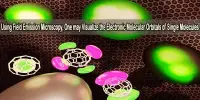Researchers have been attempting to learn more about the effects of various types of nitrogen, such as nitrate or ammonium, on the proliferation of harmful algal blooms (HABs) ever since it was discovered to be a driving force behind environmentally and economically damaging harmful algal blooms (HABs) throughout the world.
At the University of Delaware, Kathyrn Coyne, associate professor in the School of Marine Science and Policy (SMSP), has spent several years studying HABs including Heterosigma akashiwo, a globally distributed toxic species of alga. About 10 years ago, with funds from Delaware Sea Grant (DESG), Coyne’s lab discovered that Heterosigma akashiwo is able to use nitric oxide as a nitrogen source.
It accomplishes this by altering nitrate reductase in a certain way. Normally, this enzyme catalyzes the initial step of the transformation of nitrate into ammonium, a more usable form of nitrogen. Heterosigma akashiwo’s nitrate reductase has been altered, enabling it to use nitric oxide as a source of nitrogen instead of nitrate.
“This kind of raised a lot of questions,” Coyne said. “Where would they be accessing nitric oxide in the environment? What kind of advantage does it give Heterosigma akashiwo to have this modification in their enzyme? And how do other types of nitrogen affect its ability to use nitric oxide?”
The last question was answered in a recent article about the results of the research in Scientific Reports.
People often study the effects of nitrogen on blooms and how to prevent blooms in the first place by reducing nitrate or ammonium. Now, we’re saying, ‘Ok, add nitric oxide to that list because it could be important.’
Emily Healey
The lead author on this paper, Emily Healey, received her master’s degree at UD in marine biosciences and is a doctoral student at the University of Maryland School of Public Health. Along with Coyne, other co-authors include Joanna York, professor in the School of Marine Science and Policy and Director of DESG, and Robinson Fulweiler, professor in the Department of Earth and Environment at Boston University, as well as past members of Coyne’s lab, Stacie Flood and Patience Bock.
REU participant
Healey said that “while she joined Coyne’s lab as a master’s student in the summer of 2019, she came to UD and worked with Coyne earlier as a participant in the SMSP Research Experiences for Undergraduates (REU) summer program.”
“I have always been interested in microbiology and to have the opportunity to spend my summer at the beach through the REU program was pretty amazing,” Healey said. “Dr. Coyne runs a great lab. She had really helpful Ph.D. students working for her, and I just loved the work. I had never worked with algae before I had been doing more with bacteria so it was interesting to get immersed in a different microbe.”
After her REU experience, Healey was able to come back the next year to start her master’s program. During that time, she began the research which would eventually lead to this recent publication.
Nitrate reductase
Healey stated that one of her studies’ objectives was to determine whether additional nitrogen sources have an impact on Heterosigma akashiwo’s nitrate reductase activity and its capacity to absorb nitric oxide.
For example, if there is a lot of ammonium present in an environment from agricultural sources, most species will down-regulate the nitrate reductase enzyme, which might affect Heterosigma’s ability to use nitric oxide.
“We thought if there’s a lot of ammonium, maybe Heterosigma akashiwo isn’t able to use nitric oxide as a source of nitrogen,” said Healey. “Maybe if there’s ammonium present, they simply turn off that enzyme.”
It was possible that Heterosigma akashiwo may be inhibited or even prevented from accessing nitric oxide and converting it into biomass by turning off the enzyme in the presence of ammonium.
However, they discovered that even in the presence of ammonium, adding nitric oxide to cultures of Heterosigma akashiwo actually boosted the enzyme’s activity, allowing it to successfully take up nitric oxide and convert it to biomass.
The researchers carried out three studies to ascertain how nitrogen of various kinds affected nitrate reductase. They grew Heterosigma akashiwo in the lab first with only nitrate, then with only ammonium, and finally with a 50/50 mix of nitrate and ammonium.
Each experiment revealed that nitric oxide not only boosted the activity of the enzyme nitrate reductase when it was supplied, but that Heterosigma was also integrating nitric oxide into biomass when ammonium was present.
Coyne said this ability potentially gives Heterosigma akashiwo an advantage over other species, by allowing them to access a novel source of nitrogen.
“If that were the case, then Heterosigma may be able to use nitric oxide as an alternative that other species simply don’t have access to,” said Coyne.
Nitrogen in the sediments
Heterosigma akashiwo will travel up to the surface of the water during the day and return to the bottom of the water column during the night; this ability to utilise nitric oxide as a nitrogen source may have something to do with how the species moves during the day.
“At night, Heterosigma migrates to the sediments and then during the day time, they’re photosynthetic so they move up to the surface where they are exposed to sunlight,” said Coyne. “There is a lot of data showing that nitric oxide seeps up through the sediments in some coastal areas, so we think Heterosigma may be accessing that nitric oxide as a nitrogen source at night.”
Healey said this ability to use nitric oxide may have a few implications. One would be that when other types of nitrogen have been depleted, Heterosigma akashiwo has an advantage over other algae.
In addition, Healey said that nitric oxide should be considered a factor in bloom formation for Heterosigma akashiwo.
“People often study the effects of nitrogen on blooms and how to prevent blooms in the first place by reducing nitrate or ammonium,” said Healey. “Now, we’re saying, ‘Ok, add nitric oxide to that list because it could be important.’”
















